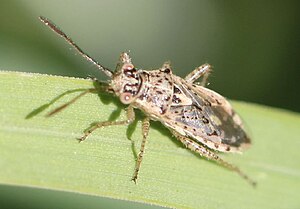Brachycarenus tigrinus
| Brachycarenus tigrinus | ||||||||||||
|---|---|---|---|---|---|---|---|---|---|---|---|---|

Brachycarenus tigrinus |
||||||||||||
| Systematics | ||||||||||||
|
||||||||||||
| Scientific name | ||||||||||||
| Brachycarenus tigrinus | ||||||||||||
| ( Schilling , 1829) |
Brachycarenus tigrinus is a bug from the family of glass wing bugs (Rhopalidae).
features
The bugs are 6.2 to 7.0 millimeters long. They have a straw yellow basic color with black patterns. This can be found on the head especially around the compound eyes. The pronotum is spotted black, especially at the rear corners. The scutellum has a black basal pattern. The head of the animals is shorter and less pointed than in the representatives of the genera Rhopalus and Stictopleurus .
distribution and habitat
The species is distributed from North Africa across the Mediterranean to the south of Scandinavia. Eastern their distribution extends to China. The species was introduced in eastern North America in the second half of the 20th century (earliest evidence: 1977 in New Jersey ). The species is widespread in Germany, but occurs in very different population densities. It can often be local. In Great Britain the species was first detected in 2003 in Battersea (London). Further records followed regularly in the area around the Thames estuary and finds from Surrey and Oxfordshire . Dry and warm habitats are populated, especially those with sandy soils such as ruderal and fallow areas.
Way of life
The animals live on and under various herbaceous plants. They suck on seeds that have fallen on the ground. The most important food crops originate from the family of cruciferous (Brassicaceae), such as Alyssus , Gray cress ( Berteroa ) Sisyphium , cress ( Lepidium ), thlaspi ( Thlaspi ), Biscutella , shepherd's purse ( Capsella ) and others. It has been documented that the adults also suckle on the foxtail family (Chenopodiaceae), legumes (Fabaceae) such as clover ( Trifolium ) and daisy family (Asteraceae) such as Artemisia . It has also imagines heather ( Calluna found) where the animals but probably just hibernated. The adults are very active in flight, especially at high temperatures. They can be found in the search for suitable winter locations on various plants, including conifers, and they can occasionally penetrate buildings. Overwintering takes place in the litter or under plant rosettes, such as mullein ( Verbascum ). One generation occurs per year, but it is assumed that in favorable years, at least in southern Germany, a second generation will also be trained. The adult animals of the new generation appear from June.
supporting documents
Individual evidence
- ↑ a b c d Wachmann: Wanzen , Vol. 3, p. 236f
- ↑ a b Brachycarenus tigrinus . bugguide.net. Retrieved September 12, 2018.
- ↑ a b Brachycarenus tigrinus. British Bugs, accessed June 21, 2014 .
literature
- Ekkehard Wachmann , Albert Melber, Jürgen Deckert: Bugs. Volume 3: Pentatomomorpha I: Aradoidea (bark bugs), Lygaeoidea (ground bugs, etc.), Pyrrhocoroidea (fire bugs) and Coreoidea (edge bugs, etc.). (= The animal world of Germany and the adjacent parts of the sea according to their characteristics and their way of life . 78th part). Goecke & Evers, Keltern 2007, ISBN 978-3-937783-29-1 .
Web links
- Brachycarenus tigrinus in Fauna Europaea. Retrieved June 21, 2014
